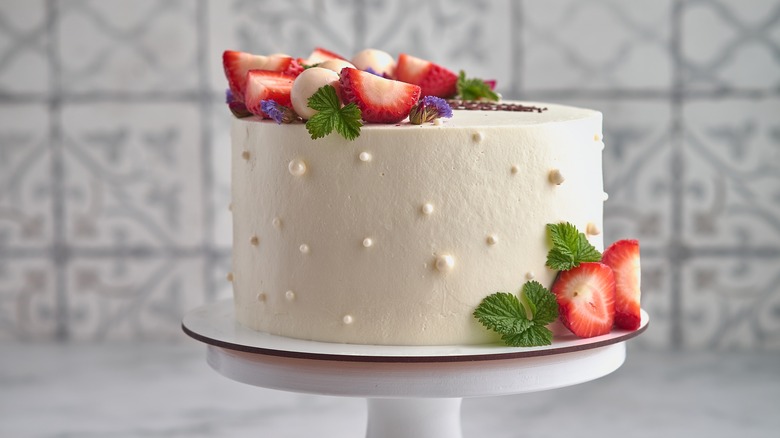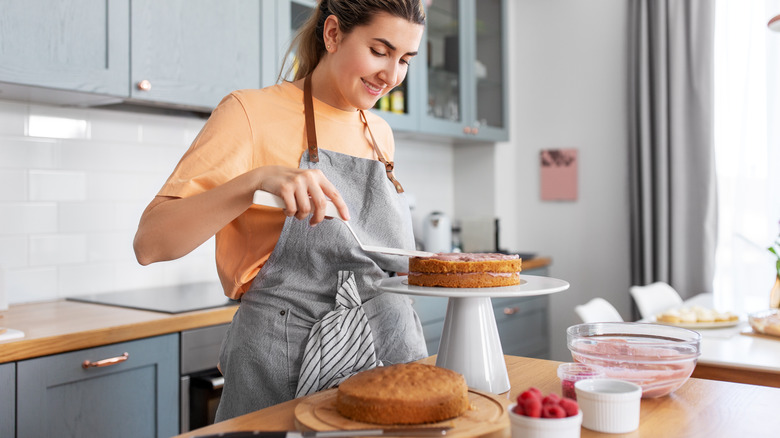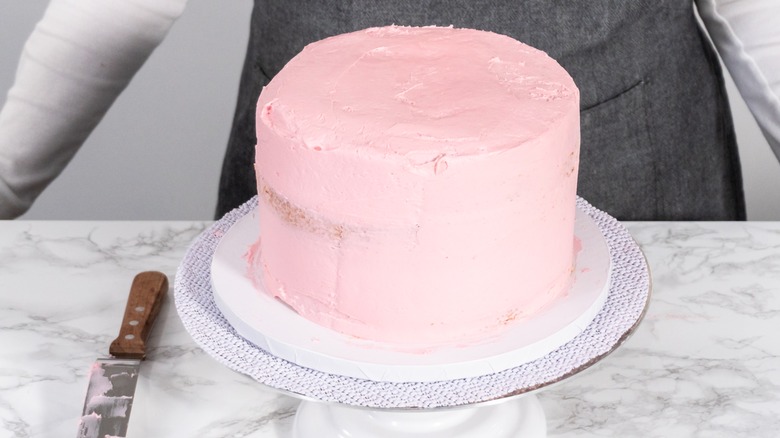The Dollop Method For Beautifully Frosted Cakes Every Time
If you're a beginner cake decorator, you might have some difficulty frosting your cake so it comes out smooth and free of crumbs. Some common mistakes when frosting cakes include trying to frost the cake before it's fully cooled, not using a crumb coat, and adding too much frosting on the cake all at once. However, there is one method that can make frosting easy and smooth, and it does involve piling it on.
While a crumb coat can ensure that your cake has a sleek finish, it can be time-consuming to frost the entire cake once, chill it, and then frost it all over again. If you want to save time, the dollop method may be a better option for creating a perfectly decorated cake.
The method involves plopping about half your frosting out onto the top of the cake, in the very center. Then, using a large offset spatula, carefully spreading the frosting outwards from the center, in all directions, without letting the frosting fall over the sides. You should gradually and gently push the icing out to cover the top of the cake, giving a nice, even coat.
Plop that frosting on top of the cake
As your frosting spreads out from that central dollop point, be sure not to thin it out too much. While you will want an even, smooth coating, overdoing it could cause some of the cake's crumbs to dislodge and get caught up in the icing. Work slowly and carefully, leveling the frosting out as you go so that you don't wind up with an uneven layer of frosting on top. Turning your cake as you go is a good way to ensure an even spread.
When it comes to spreading out that frosting, the temperature matters. Whether you're using a can of store-bought frosting or you've whipped up your favorite homemade American buttercream recipe, you'll want to make sure that your frosting is room temperature. This will make it easier to spread around the cake with your spatula.
If your frosting is too cold, it will be difficult to work with, and you run the risk of pulling apart the top layer of the cake — and all those crumbs winding up in your frosting. If it's too warm, on the other hand, your frosting could wind up being too runny, and it may not hold its shape well. Room temperature frosting will be the perfect blend of spreadable and sturdy.
You can use this method for a crumb coat, too
If you do accidentally spread your frosting a little too thin and capture some crumbs, there is still a way to salvage it. Instead of simply piling on even more frosting that could still show some crumbs, you can embrace it and turn that layer into a crumb coat. A crumb coat will keep any loose cake crumbs trapped in the thin frosting layer.
Once the frosting has been thinned out on the cake, place the cake in the fridge or freezer. This will help the crumb coat frosting to set, and it will be less likely to come off and become incorporated into the final frosting. Then, once your cake is properly chilled, add some fresh frosting on top and repeat the dollop method. That base crumb coat layer will act as a barrier between the cake's crumbs and your fresh buttercream, resulting in a super smooth finish.
Once your cake has been fully frosted, you can top it off with extra decorations: sprinkles, piping, fruit, or nuts — your imagination is the limit. So the next time you need to quickly frost a cake, try dolloping your frosting on top. Once it's spread and smoothed out, your cake will look just as good as it tastes.


